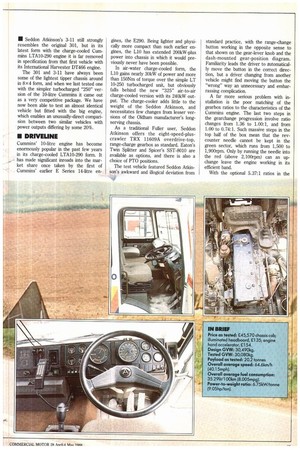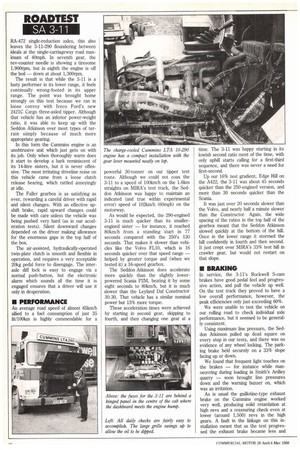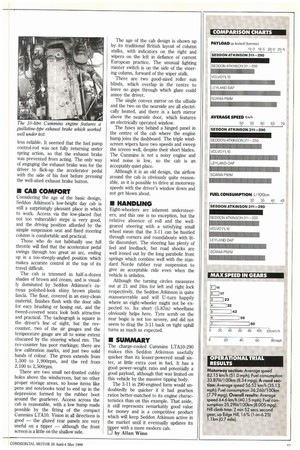SECOND TIM AROUND
Page 56

Page 57

Page 58

Page 59

If you've noticed an error in this article please click here to report it so we can fix it.
• Seddon Atkinson's 3-11 still strongly resembles the original 301, but in its latest form with the charge-cooled Cummins LTA10-290 engine it is far removed in specification from that first vehicle with its International Harvester DT466 engine.
The 301 and 3-11 have always been some of the lightest tipper chassis around in 8x4 form, and when we last tested one with the simpler turbocharged "250" version of the 10-litre Cummins it came out as a very competitive package. We have now been able to test an almost identical vehicle but fitted with the big engine, which enables an unusually-direct comparision between two similar vehicles with power outputs differing by some 20%.
• DRIVELINE
Cummins' 10-litre engine has become enormously popular in the past few years in its charge-cooled LTA10-290 form. It has made significant inroads into the market share once taken by the first of Cummins' earlier E Series 14-litre en gines, the E290. Being lighter and physically more compact than such earlier engines, the L10 has extended 200kW-plus power into chassis in which it would previously never have been possible.
In air-water charge-cooled form, the L10 gains nearly 30kW of power and more than 150Nm of torque over the simple LT 10-250 turbocharged unit, but obviously falls behind the new "325" air-to-air charge-cooled version with its 240kW output. The charge-cooler adds little to the weight of the Seddon Atkinson, and necessitates few changes from lesser versions of the Oldham manufacturer's longserving chassis.
As a traditional Fuller user, Seddon Atkinson offers the eight-speed-pluscrawler TRX 11609A overdrive-top, range-charge gearbox as standard. Eaton's Twin Splitter and Spicer's SST-8010 are available as options, and there is also a choice of PTO positions.
The test vehicle featured Seddon Atkinson's awkward and illogical deviation from standard practice, with the range-change button working in the opposite sense to that shown on the gear-lever knob and the dash-mounted gear-position diagram. Familiarity leads the driver to automatically move the button in the correct direction, but a driver changing from another vehicle might find moving the button the "wrong" way an unnecessary and embarrassing complication.
A far more serious problem with installation is the poor matching of the gearbox ratios to the characteristics of the Cummins engine. The last two steps in the gearchange progression involve ratio changes from 1.36 to 1.00:1, and from 1.00 to 0.74:1. Such massive steps in the top half of the box mean that the revcounter needle cannot be kept in the green sector, which runs from 1,500 to 1,900rpm. Only by running the needle into the red (above 2,100rpm) can an upchange leave the engine working in its efficient band.
With the optional 5.37:1 ratios in the RA-472 single-reduction axles, this also leaves the 3-11-290 floundering between ideals at the single-carriageway road maximum of 40mph. In seventh gear, the rev-counter needle is showing a tiresome 1,900rpm, but in eighth the engine is off the boil — down at about 1,300rpm.
The result is that while the 3-11 is a lusty performer in its lower range, it feels continually wrong-footed in its upper range. The point was brought home strongly on this test because we ran in loose convoy with Iveco Ford's new 2421C Cargo three-axled tipper. Although that vehicle has an inferior power-weight ratio, it was able to keep up with the Seddon Atkinson over most types of terrain simply because of much more appropriate gearing.
In this form the Ctunmins engine is an unobtrusive unit which just gets on with its job. Only when thoroughly warm does it start to develop a bark reminiscent of its 14-litre sisters, but it is never offensive. The most irritating driveline noise on this vehicle came from a loose clutch release bearing, which rattled annoyingly at idle.
The Fuller gearbox is as satisfying as ever, rewarding a careful driver with rapid and silent changes. With an effective upshift brake, rapid upward changes could be made with care unless the vehicle was being pushed very hard (as in our acceleration tests). Silent downward changes depended on the driver making allowance for the enormous gaps in the top half of the box.
The air-assisted, hydraulically-operated twin-plate clutch is smooth and flexible in operation, and requires a very acceptable 20kg pedal force to disengage. The interaxle cliff lock is easy to engage via a normal push-button, but the electronic alarm which sounds all the time it is engaged ensures that a driver will use it only in desperation.
• PERFORMANCE
An average road speed of almost 65km/h allied to a fuel consumption of just 35 lit/100km is highly commendable for a powerful 30-tonner on our tipper test route. Although we could not coax the 3-11 to a speed of 1001cm/h on the 1.6km straights on MIRA's test track, the Seddon Atkinson was happy to maintain an indicated (and true within experimental error) speed of 102km/h (60mph) on the motorway.
As would be expected, the 290-engined 3-11 is much quicker than its smallerengined sister — for instance, it reached 80kni/h from a standing start in 77 seconds compared with the 250's 130 seconds. That makes it slower than vehicles like the Volvo FL10, which is 16 seconds quicker over that speed range — helped by greater torque and (when we tested it) a 16-speed gearbox.
The Seddon Atkinson does accelerate more quickly than the slightly lowerpowered Scania P2M, beating it by some eight seconds to 80km/h, but it is much slower than the Leyland Daf Constructor 30.30. That vehicle has a similar nominal power but 13% more torque.
These acceleration times were achieved by starting in second gear, skipping to fourth, and then changing one gear at a time. The 3-11 was happy starting in its lowish second ratio most of the time, with only uphill starts calling for a first-third sequence, and there was never a need for first-second.
Up our 16% test gradient, Edge Hill on the A422, the 3-11 was about 45 seconds quicker than the 250-engined version, and more than 30 seconds quicker than the Scania.
It was just over 20 seconds slower than the Volvo, and nearly half a minute slower than the Constructor. Again, the wide spacing of the ratios in the top half of the gearbox meant that the Seddon Atkinson slowed quickly at the bottom of the hill. Once in the lower range it stormed the hill confidently in fourth and then second. It just crept over MIRA's 33% test hill in crawler gear, but would not restart on that slope.
• BRAKING
In service, the 3-11's Rockwell S-cam brakes have good pedal feel and progressive action, and pull the vehicle up well. On the test track they proved to have a low overall performance, however, the peak efficiencies only just exceeding 60%.
We were unable to test the vehicle on our rolling road to check individual axle performance, but it seemed to be generally consistent.
Using maximum line pressure, the Seddon Atkinson pulled up dead square on every stop in our tests, and there was no evidence of any wheel locking. The parking brake held securely on a 33% slope facing up or down.
We found that frequent light touches on the brakes — for instance while manoeuvring during loading in Smith's Ardley quarry — soon brought line pressures down and the warning buzzer on, which was an irritation.
As is usual the guillotine-type exhaust brake on the Cummins engine worked very well, producing solid retardation at high revs and a reassuring check even at lower (around 1,500) revs in the high gears. A fault in the linkage on this installation meant that as the test progressed the exhaust brake became less and less reliable. It seemed that the fuel pump control-rod was not fully returning under spring action, so that the exhaust brake was prevented from acting. The only way of engaging the exhaust brake was for the driver to flick-up the accelerator pedal with the side of his foot before pressing the well-sited exhaust brake button.
• CAB COMFORT
Considering the age of the basic design, Seddon Atkinson's low-height day cab is still a surprisingly pleasant place in which to work_ Access via the low-placed (but not too vulnerable) steps is very good, and the driving position afforded by the simple suspension seat and fixed steering column is comfortable and practical.
Those who do not habitually use full throttle will find that the accelerator pedal swings through too great an arc, ending up in a too-steeply-angled position which makes accurate control at the top of its travel difficult.
The cab is trimmed in half-a-dozen shades of brown and cream, and is visually dominated by Seddon Atkinson's curious polished-look shiny brown plastic fascia. The floor, covered in an easy-clean material, finishes flush with the door sills for eacy brushing or hosing out, and the tweed-covered seats look both attractive and practical. The tachograph is square in the driver's line of sight, but the revcounter, two of the air gauges and the temperature gauge are all to some extent obscured by the steering wheel rim. The rev-counter has poor markings; there are few calibration marks, and just two solid bands of colour. The green extends from 1,500 to 1,900rpm, and the red from 2,100 to 2,500rpm.
There are two small net-fronted cubby holes above the windscreen, but no other proper storage areas, so loose items like pens and notebooks tend to end up in the depression formed by the rubber boot around the gearlever. Access across the cab is reasonable, with a low hump made possible by the fitting of the compact Cummins LTA10. Vision in all directions is good — the glazed rear panels are very useful on a tipper — although the front screen is a little on the shallow side. The age of the cab design is shown up by its traditional British layout of column stalks, with indicators on the right and wipers on the left in defiance of current European practice. The unusual lighting master switch is on the side of the steering column, forward of the wiper stalk.
There are two good-sized roller sun blinds, which overlap in the centre to leave no gaps through which glare could annoy the driver.
The single convex mirror on the offside and the two on the nearside are all electrically heated, and there is a kerb mirror above the nearside door, which features an electrically operated window.
The fuses are behind a hinged panel in the centre of the cab where the engine hump joins the dashboard. The triple windscreen wipers have two speeds and sweep the screen well, despite their short blades. The Cummins is not a noisy engine and wind noise is low, so the cab is an acceptably quiet place.
Although it is an old design, the airflow around the cab is obviously quite reasonable, as it is possible to drive at motorway speeds with the driver's window down and not get blown about.
• HANDLING
Eight-wheelers are inherent understeerers, and this one is no exception, but the relative absence of roll and the wellgeared steering with a satisfying small wheel mean that the 3-11 can be hustled through corners and roundabouts with little discomfort. The steering has plenty of feel and feedback, but road shocks are well ironed out by the long parabolic front springs which combine well with the standard Norde rubber rear suspension to give an acceptable ride even when the vehicle is unladen.
Although the turning circles measures out at 21 and 24m for left and right lock respectively, the Seddon Atkinson is quite manoeuvrable and will U-turn happily where an eight-wheeler might not be expected to. Its short (5.87m) wheelbase obviously helps here. Tyre scrub on the rear bogie is not too severe, and did not seem to drag the 3-11 back on tight uphill turns as much as expected.
• SUMMARY
The charge-cooled Cummins LTA10-290 makes this Seddon Atkinson usefully quicker than its lesser-powered small sister, at little extra cost in fuel. It has a good power-weight ratio and potentially a good payload, although that was limited on this vehicle by the massive tipping body.
The 3-11 in 290-engined form would undoubtedly be quicker if it had gearbox ratios better-matched to its engine characteristics than on this example. That aside, it still represents remarkably good value for money and is a competitive product which will keep Seddon Atkinson active in the market until it eventually updates its tipper with a more modern cab.
by Allan Winn




















































































































































